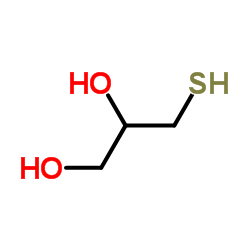3-Mercaptopropane-1,2-diol

3-Mercaptopropane-1,2-diol structure
|
Common Name | 3-Mercaptopropane-1,2-diol | ||
|---|---|---|---|---|
| CAS Number | 96-27-5 | Molecular Weight | 108.159 | |
| Density | 1.2±0.1 g/cm3 | Boiling Point | 247.0±0.0 °C at 760 mmHg | |
| Molecular Formula | C3H8O2S | Melting Point | N/A | |
| MSDS | Chinese USA | Flash Point | 126.3±24.6 °C | |
| Symbol |

GHS06 |
Signal Word | Danger | |
|
UNC45A localizes to centrosomes and regulates cancer cell proliferation through ChK1 activation.
Cancer Lett. 357(1) , 114-20, (2014) The UCS family of proteins regulates cellular functions through their interactions with myosin. Here we show that one member of this family, UNC45A, is also a novel centrosomal protein. UNC45A is required for cellular proliferation of cancer cell in vitro and... |
|
|
Compact and blinking-suppressed quantum dots for single-particle tracking in live cells.
J. Phys. Chem. B 118(49) , 14140-7, (2014) Quantum dots (QDs) offer distinct advantages over organic dyes and fluorescent proteins for biological imaging applications because of their brightness, photostability, and tunability. However, a major limitation is that single QDs emit fluorescent light in a... |
|
|
Optical reconstruction of murine colorectal mucosa at cellular resolution.
Am. J. Physiol. Gastrointest. Liver Physiol. 308 , G721-35, (2015) The mucosal layer of the colon is a unique and dynamic site where host cells interface with one another and the microbiome, with major implications for physiology and disease. However, the cellular mechanisms mediating colonic regeneration, inflammation, dysp... |
|
|
Thioredoxin-interacting protein regulates the differentiation of murine erythroid precursors.
Exp. Hematol. 43 , 393-403.e2, (2015) Thioredoxin-interacting protein (TXNIP) is involved in various cellular processes including redox control, metabolism, differentiation, growth, and apoptosis. With respect to hematopoiesis, TXNIP has been shown to play roles in natural killer cells, dendritic... |
|
|
Generation of Brain Microvascular Endothelial-Like Cells from Human Induced Pluripotent Stem Cells by Co-Culture with C6 Glioma Cells.
PLoS ONE 10 , e0128890, (2015) The blood brain barrier (BBB) is formed by brain microvascular endothelial cells (BMECs) and tightly regulates the transport of molecules from blood to neural tissues. In vitro BBB models from human pluripotent stem cell (PSCs)-derived BMECs would be useful n... |
|
|
Hypoxia enhances differentiation of mouse embryonic stem cells into definitive endoderm and distal lung cells.
Stem Cells Dev. 24(5) , 663-76, (2015) We investigated the effects of hypoxia on spontaneous (SP)- and activin A (AA)-induced definitive endoderm (DE) differentiation of mouse embryonic stem cells (mESCs) and their subsequent differentiation into distal pulmonary epithelial cells. SP differentiati... |
|
|
Surface display of an anti-DEC-205 single chain Fv fragment in Lactobacillus plantarum increases internalization and plasmid transfer to dendritic cells in vitro and in vivo.
Microb. Cell Fact. 14 , 95, (2015) Lactic acid bacteria (LAB) are promising vehicles for delivery of a variety of medicinal compounds, including antigens and cytokines. It has also been established that LAB are able to deliver cDNA to host cells. To increase the efficiency of LAB-driven DNA de... |
|
|
A modified EpiSC culture condition containing a GSK3 inhibitor can support germline-competent pluripotency in mice.
PLoS ONE 9(4) , e95329, (2014) Embryonic stem cells (ESCs) can contribute to the tissues of chimeric animals, including the germline. By contrast, epiblast stem cells (EpiSCs) barely contribute to chimeras. These two types of cells are established and maintained under different culture con... |
|
|
Gaucher Disease-Induced Pluripotent Stem Cells Display Decreased Erythroid Potential and Aberrant Myelopoiesis.
Stem Cells Transl. Med. 4 , 878-86, (2015) Gaucher disease (GD) is the most common lysosomal storage disease resulting from mutations in the lysosomal enzyme glucocerebrosidase (GCase). The hematopoietic abnormalities in GD include the presence of characteristic Gaucher macrophages that infiltrate pat... |
|
|
MicroRNA in exosomes isolated directly from the liver circulation in patients with metastatic uveal melanoma.
BMC Cancer 14 , 962, (2015) Uveal melanoma is a tumour arising from melanocytes of the eye, and 30 per cent of these patients develop liver metastases. Exosomes are small RNA containing nano-vesicles released by most cells, including malignant melanoma cells. This clinical translational... |